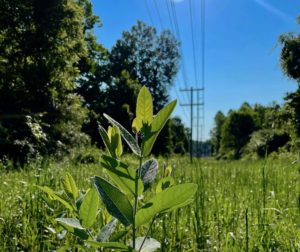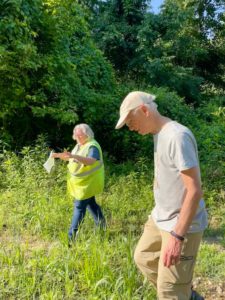Athens Conservancy is providing research space at its Mary Beth Zak Lohse Preserve – where AEP has an easement for electric power lines that serve the area – for four quarter-acre test plots and a control plot. Each test site was hydroseeded (planted with a forceful spray of water) with a mixture of native-plant seeds, selected to grow robustly in the region. The native seed plots are part of post-construction rights-of-way site restoration
 “Our goal is to determine the amount of seeds and types of native seeds in a mix that will be most successful at this site,” said Amy Toohey, environmental specialist consultant, AEP Environmental Services. “Researchers at EPRI are conducting a two-year field study in collaboration with biologists from Stantec to help inform the seeding rate and native seed mixes.”
“Our goal is to determine the amount of seeds and types of native seeds in a mix that will be most successful at this site,” said Amy Toohey, environmental specialist consultant, AEP Environmental Services. “Researchers at EPRI are conducting a two-year field study in collaboration with biologists from Stantec to help inform the seeding rate and native seed mixes.”
“Once the data is back, it will help us determine what to plant, what not to plant, where to plant, and what will grow best,” said Scott McManus, AEP transmission construction representative. “It will tell us what we can effectively grow in a timely way. If things grow the first time, it saves AEP from coming back to replant.”
He explained AEP cannot close a construction job in Ohio until plant growth covers 70% of the site. “We thought, why not cover sites with something other than just grass?” he says. “We want plants that grow quickly but also want to include native plants that will endure and thrive.”
The seed mixes – formulated for use by utility companies – include native grasses such as Canada wild rye and big bluestem, along with native flowering plants such as slender mountain mint, purple coneflower, showy tickseed, black-eyed Susan, smooth aster and partridge pea. The research will evaluate erosion effects and how well the native plants are establishing.
Toohey hopes the endeavor will prove the effectiveness of using native plants. “We hope to show a diversity of plants like native  grasses and wildflowers are not only good for restoration but also nice for people and pollinators.”
grasses and wildflowers are not only good for restoration but also nice for people and pollinators.”
AEP has conducted similar projects at Dawes Arboretum and Clear Creek Metro Park in central Ohio. The utility company choseAthens Conservancy’s preserve for the research project because of site suitability and the Conservancy’s willingness to take part in this study.
Explains Phil Cantino, Athens Conservancy board member and plant biologist, “Athens Conservancy welcomes environmental research provided it does not negatively impact our land and its biodiversity. This AEP project is exciting because of its potential for far-reaching environmental benefit. If the results demonstrate that hydroseeding native plants is both effective and comparable in cost to seeding with non-native grasses — as is commonly done to restore construction sites — AEP and other companies may adopt this new approach broadly. The consequence would be increased native plant diversity and better pollinator habitat in utility right-of-way throughout Ohio and beyond.”

